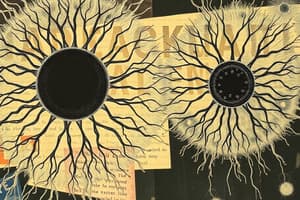Podcast
Questions and Answers
What is the main function of the Golgi apparatus in a cell?
What is the main function of the Golgi apparatus in a cell?
- Protein synthesis
- Energy production
- Waste digestion
- Modifying, sorting, and packaging proteins and lipids for transport (correct)
What is the primary function of mitochondria in a cell?
What is the primary function of mitochondria in a cell?
- Waste digestion
- Protein synthesis
- Storing genetic material
- Cellular respiration and energy production (correct)
What is the main difference between prokaryotic and eukaryotic cells?
What is the main difference between prokaryotic and eukaryotic cells?
- Presence or absence of a cell wall
- Number of cells in the organism
- Presence or absence of a true nucleus (correct)
- Type of genetic material
What is the function of ribosomes in a cell?
What is the function of ribosomes in a cell?
What is the purpose of the endoplasmic reticulum (ER) in a cell?
What is the purpose of the endoplasmic reticulum (ER) in a cell?
What is the main function of lysosomes in a cell?
What is the main function of lysosomes in a cell?
What is unique about the cell membrane?
What is unique about the cell membrane?
What is the purpose of the nucleus in a cell?
What is the purpose of the nucleus in a cell?
Flashcards are hidden until you start studying
Study Notes
###细胞理论
- Cells are the basic structural and functional units of living organisms
- All living organisms are composed of cells, either single-celled (unicellular) or multi-celled (multicellular)
- Cells arise from pre-existing cells
Prokaryotic and Eukaryotic Cells
- Prokaryotic cells (bacteria) lack a true nucleus and have their genetic material in the cytoplasm
- Eukaryotic cells (plants, animals, fungi, and protists) have a true nucleus that contains genetic material
- Both types of cells have genetic material, cytoplasm, and ribosomes
- Prokaryotic cells lack membrane-bound organelles, whereas eukaryotic cells have them
Cell Membrane and Cytoplasm
- Cell membrane (plasma membrane) is semi-permeable, regulating the flow of materials into and out of the cell
- Cytoplasm is a jelly-like substance that contains organelles and supports cellular activities
- Cytoplasm is present in both prokaryotic and eukaryotic cells
- Organelles in the cytoplasm include ribosomes, which produce proteins
Ribosomes
- Ribosomes are non-membrane-bound organelles found in both prokaryotic and eukaryotic cells
- They synthesize proteins based on genetic information from DNA
- Ribosomes may be free in the cytoplasm or attached to the endoplasmic reticulum
Eukaryotic Cell Organelles
- Nucleus contains genetic material (DNA) and controls cellular activities
- Nucleus has a nuclear envelope and nucleolus, where ribosomes are synthesized
- Endoplasmic reticulum (ER) is a network of membranous tubules and sacs
- ER has two types: rough ER (with ribosomes) and smooth ER (without ribosomes)
- Rough ER is involved in protein synthesis and transport
- Smooth ER is involved in detoxification and lipid synthesis
Golgi Apparatus
- Golgi apparatus is a complex of flattened sacs and tubules
- It receives vesicles from the ER and modifies, sorts, and packages proteins and lipids for transport
- Golgi apparatus determines the destination of proteins and lipids
Mitochondria
- Mitochondria are organelles found in both plant and animal cells
- They generate energy for the cell through cellular respiration
- Mitochondria use glucose and oxygen to produce ATP
Other Organelles
- Lysosomes are membrane-bound sacs that contain digestive enzymes
- Peroxisomes are involved in the breakdown of fatty acids and amino acids
- Plant cells have a central vacuole that stores materials and helps maintain cell shape
- Animal cells have multiple small vacuoles for storage and other functions
- Plant cells have a cell wall that provides additional protection and shape maintenance
Cell Theory
- Living organisms are composed of cells, which are the basic structural and functional units
- Cells arise from pre-existing cells, and all living organisms are either single-celled (unicellular) or multi-celled (multicellular)
Cell Types
- Prokaryotic cells lack a true nucleus and have genetic material in the cytoplasm
- Eukaryotic cells have a true nucleus containing genetic material
- Both cell types have genetic material, cytoplasm, and ribosomes
Cell Structure
- Cell membrane is semi-permeable, regulating the flow of materials into and out of the cell
- Cytoplasm is a jelly-like substance containing organelles and supporting cellular activities
- Prokaryotic cells lack membrane-bound organelles, whereas eukaryotic cells have them
Ribosomes
- Ribosomes are non-membrane-bound organelles in both prokaryotic and eukaryotic cells
- They synthesize proteins based on genetic information from DNA
- Ribosomes may be free in the cytoplasm or attached to the endoplasmic reticulum
Eukaryotic Cell Organelles
- Nucleus contains genetic material (DNA) and controls cellular activities
- Nucleolus is the site of ribosome synthesis
- Endoplasmic reticulum (ER) is a network of membranous tubules and sacs
- ER has two types: rough ER (with ribosomes) for protein synthesis and transport, and smooth ER (without ribosomes) for detoxification and lipid synthesis
Golgi Apparatus
- Golgi apparatus receives vesicles from the ER and modifies, sorts, and packages proteins and lipids for transport
- It determines the destination of proteins and lipids
Mitochondria
- Mitochondria generate energy for the cell through cellular respiration
- They use glucose and oxygen to produce ATP
Other Organelles
- Lysosomes contain digestive enzymes for cellular digestion
- Peroxisomes break down fatty acids and amino acids
- Plant cells have a central vacuole for storage and maintaining cell shape
- Animal cells have multiple small vacuoles for storage and other functions
- Plant cells have a cell wall providing additional protection and shape maintenance
Studying That Suits You
Use AI to generate personalized quizzes and flashcards to suit your learning preferences.




